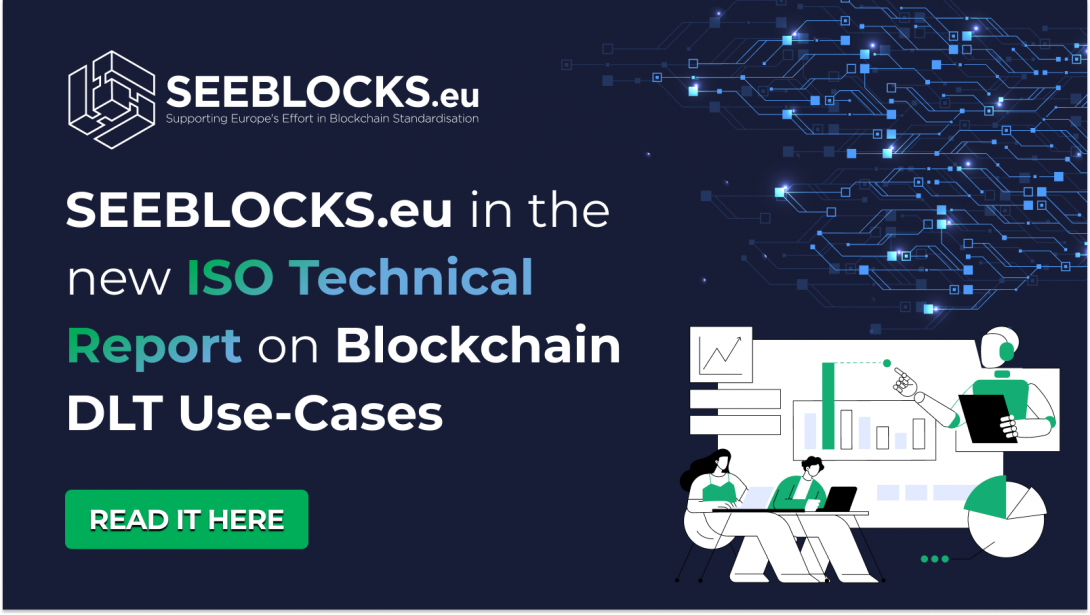SEEBLOCKS.eu in the new ISO Technical Report on Blockchain & DLT Use-Cases
13 May 2024

SEEBLOCKS is excited to announce the publication of a new ISO Technical Report in the blockchain/distributed ledger technologies (DLT) sector. SEEBLOCKS.eu is particularly proud of this publication because of the key contributions of representatives of the SEEBLOCKS consortium and the SEEBLOCKS Strategy Board.
The new Technical Report ISO/TR 6277:2024 Blockchain and distributed ledger technologies — Data flow models for blockchain and DLT use cases provides a framework for data flow analysis of blockchain and DLT use cases. The technical report was developed by formal consensus at ISO TC307 WG6 (convened by Caroline Thomas (BSI), a SEEBLOCKS Strategy Board member) and led by Dr. Xiaodan Tang (CESI), and Fiona Delaney (NSAI) (SEEBLOCKS Strategy Lead) who collaborated with experts across the globe in the consolidation of a set of models that describe the flows of different types of data between DLT and related systems, as well as between different DLT nodes.
The usage of the word consolidation here is due to a pre-existing standard (ISO 23257:2022) and Technical Report (ISO/TR 3242:2022) which had already defined and first applied a set of data flow models to DLT use cases – with such success that the community felt that it would be worthwhile to consolidate the experience and extend the approach even further to capture its many benefits.
A robust set of use cases is essential to blockchain/DLT success. The first SEEBLOCKS Public Consultation revealed that the highest priority concern of citizens is that the technology, even after several years, is still not well understood and appreciated in business and society. The descriptive capabilities provided in this new Technical Report will make an important contribution to improving blockchain and DLT application design and building up that essential set of use cases needed to illustrate to the public and business communities the transformative potential of blockchain/DLT. The use cases described not only deliver insights into specific applications but also shed light on emerging digital business domains including international eCommerce, metaverse content commissioning and licencing, and food safety compliance in commercial fish farm insurance.
Why, then, is “data flow modelling” so important in the development of use cases? Because understanding data flows between the participants in blockchain/DLT use cases (citizens, banks, public administrations, companies) helps to bring out critical issues like data privacy, security, and confidentiality. Well-documented data flows help us to balance business value maximisation (important for companies) and risk control (important for us all!).
To help the reader grasp the important concepts, the Technical Report helpfully provides three example use cases that demonstrate the modelling of data flows between devices, users, business processes, and so forth. It also provides a detailed breakdown of the various types of data flows into five fundamental types (e.g., inside the DLT system, between user applications and the DLT system, and so forth). Likewise, it devotes attention to analysing important emerging categories of data storage. For example, the storage of data “off-ledger” has become increasingly popular as a means of improving performance. That leads to different characteristics from traditional “on-ledger” data storage (which is immutable, leading to extra concerns for privacy and security).
Another important contribution of the new Technical Report is an analysis of the different roles of participants in DLT data flows. In a single blockchain/DLT use case, roles may range from users to administrators to data providers to application operators. The provided analysis helps the designers of new DLT use cases to do a thorough job of documenting their use case and making its functionality crystal clear and transparent for the reader. It also assists the use case designer in uncovering potential issues of interoperability, security, and governance.
SEEBLOCKS is proud to be associated with the publication of this new Technical Report, and we look forward to using its insights in our own work, discovering and documenting new blockchain/DLT use cases and business domains for our community.
SUBSCRIBE TO SEEBLOCKS.EU NEWSLETTER TO RECEIVE UPDATES ON OUR ROLE ON BLOCKCHAIN LANDSCAPE